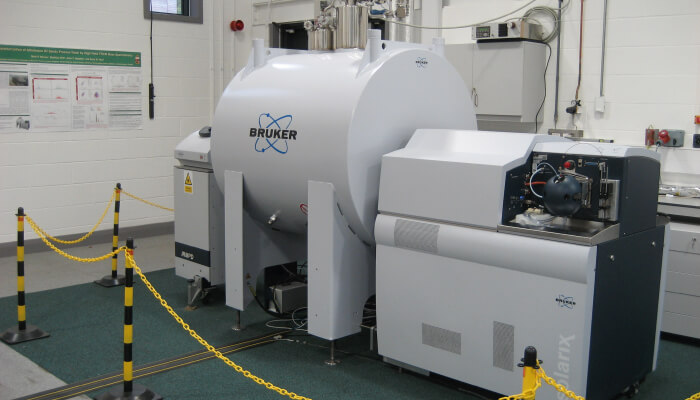The problem
For many years we struggled to analyze the maltenes components of a truly non-distillable fraction from a particular heavy petroleum sample. Along with our collaborators, we applied a variety of sample preparation and ionization approaches, but they all proved unsuccessful. The issue was – of course – the complexity of the sample.
As analytical science evolves, we must improve our experimental and data processing capabilities in order to characterize increasingly complex samples. Thus, if we are to continue to answer important questions across analytical applications, innovative new approaches are needed.

Background
Petroleum is one of nature’s most complex organic mixtures; hundreds of thousands of compositions can lie within an observed mass range, with hundreds of unique compositions per nominal mass. And, as Mieczyslaw Boduszynski states, truly non-distillable residues are by some way the most difficult fraction of such samples to analyze, due to the broad range of molecular weights present, the heteroatomic nature of the compounds, and general low volatility (1).
Luckily, the Barrow Group had expansive experience in Fourier transform ion cyclotron resonance (FT-ICR) MS – instruments which offer the very highest resolving power and mass accuracy. As a result, FT-ICR MS instruments are able to separate molecular species with very small mass differences (including compositions that differ by less than the mass of an electron), and can subsequently assign peaks to each with a high level of confidence. However, it is also widely understood that the resolving power of this technique is inversely proportional to the mass-to-charge ratio (m/z). So, for a given m/z range, the resolving power drops as the m/z rises, which is precisely where there can be a greater number of elemental compositions per nominal mass. This means that peaks become more difficult to resolve at the higher end of a given m/z range, and compositions at the upper end of the range may be missed.
What’s more, the collision cell and ion cyclotron resonance (ICR) cell trap a limited number of ions – typically in the range of millions – but a minimum number of ions (roughly 100) of the same m/z must be present to detect the signal and record a peak. These two parameters determine the peak capacity of a single mass spectrum, typically meaning instruments are limited to tens of thousands of peaks using traditional methods. Increasing the ion population in the instrument also leads to undesirable space-charge effects, reducing resolving power and mass accuracy. These factors underpin the difficulties experienced when dealing with highly complex samples and presented us with a challenge that we could not refuse to face head on.
The solution
Introducing operation at constant ultrahigh resolution (OCULAR), our approach using a combination of custom experiments and data-processing techniques.
Operating FT-ICR MS at constant ultrahigh resolution has set a new world record for the number of unique compositional assignments derived from a single sample – 244,779, to be exact (2); a considerable advance on the previous record of 126,264 compositions set in 2017 (3). The breakthrough? The use of a modified stitching method incorporating a mass filter to selectively accumulate ions for successive m/z windows of constant ultrahigh resolution per window, and a custom algorithm for processing and stitching the data, ensuring a final mass spectrum with constant resolving power across the desired m/z range. The result: data with several orders of magnitude more peaks than the tens of thousands allowed by traditional broadband FT-ICR experiments.
Determination of the number of windows to incorporate constituted a key consideration in planning the stitching method, owing to the known link between resolving power and window width; more complex samples spanning a wide m/z range will require the acquisition of a larger number of narrower segments. To achieve our record analysis of the non-distillable fraction with ultrahigh resolving power and part-per-billion mass accuracy, we divided the data set into 65 windows, each with an m/z width of 24.
The next step was to “phase” the data (producing absorption mode mass spectra) and calibrate the mass spectra, followed by use of Rhapso (4) – a novel algorithm for automated stitching, named after a character from Greek mythology suspected to have been a seamstress. Rhapso trims each segment at highest and lowest m/z to prevent including peaks outside of the isolated window, giving reduced-width segments. The corrected, reduced-width segments spanning the entire m/z range of interest were then combined to give the fully stitched mass spectrum, from which data analysis could be performed and unique molecular compositions were assigned.
As conventional sources deplete, petroleum companies are exploring heavier sources of crude oil and the truly non-distillable fractions of crude oil (with a boiling point over
687 oC) could contain high-value products that are important targets for analysis. Approximately 80 percent of the compositions we assigned had an unknown boiling point above this value, including individual molecules with up to 114 carbon atoms and up to 51 double bond equivalents spanning many heteroatom classes.
OCULAR is the only documented method to date able to obtain these results, and was performed using a 12 T FT-ICR MS instrument – the FT-ICR instruments with the very strongest magnetic fields currently available use 15 T or 21 T. We anticipate that the use of OCULAR with even higher magnetic fields and newer instrument hardware would further improve the performance of this approach, leading to a higher dynamic range and mass accuracy with reduced noise and enhanced peak positions.
Beyond the solution
We have demonstrated that OCULAR, in combination with FT-ICR MS, is effective for the characterization of heavy petroleum, but we anticipate it will also prove useful in the analysis of complex environmental samples (including weathered heavy petroleum). The growth of metabolomics, which considers many thousands of analytes within a single sample, also provides testament to the need for such approaches, and there is an emerging need for the development of even more advanced tools to combat the associated challenges.
In the age of ever-increasing sample complexity, we also expect to see OCULAR used for discerning the contents of biological samples. MS has found applications throughout modern studies of biology and medicine, from biomolecule–drug interactions to ecology and biodiversity. In these contexts, the dynamic range examined can be particularly critical; for example, a defined range may be necessary to follow species of relatively low abundance. Plus, in the case of isotopic-labeling experiments, peak resolution for complex spectra is essential for analysis of the isotopic fine structure.

In terms of our own work, we have a few ideas…. We won’t give away all the details just yet – suffice to say you should expect to see further applications and method developments hitting journals in the future. Of course, there are a number of factors that will support advances with the method, including the use of more modern ICR cells – like the “dynamically harmonized Fourier transform ion cyclotron resonance cell” or “ParaCell” – and the development of new instrument control software to boost performance and improve speed.
Speaking more broadly, the main challenges we face are the increased complexity of heavier fractions of crude oil and non-conventional sources of crude oil (such as bitumen), the requirement for advanced data analysis and visualization, and the separation of isomeric contributions, known for their influence on physical characteristics and toxicity. Thus, the developments needed to propel this research forward are many, but we look forward to the challenges.
We hope to see OCULAR used by a wide range of research groups across numerous fields in the future – not just for petroleum research. Given the analytical insight bestowed by the technique, we anticipate applications in a range of areas, where increasing interest will also drive accessibility.
References
- KH Altgelt, “Crude oil distillation and significance of AEBP”, Composition and analysis of heavy petroleum fractions, First edition, 41, CRC Press: 1993.
- DCP Lozano et al., ”Pushing the analytical limits: new insights into complex mixtures using mass spectra segments of constant ultrahigh resolving power” Chem Sci, 10, 6966 (2019). DOI: 10.1039/c9sc02903f
- LC Krajewski et al., “126,264 assigned chemical formulas from an atmospheric pressure photoionization 9.4 T Fourier transform positive ion cyclotron resonance mass spectrum”, Anal Chem, 89, 11318 (2017). DOI: 10.1021/acs.analchem.7b02004
- R Gavard et al., “Rhapso: Automatic Stitching of Mass Segments from Fourier Transform Ion Cyclotron Resonance Mass Spectra”, Anal Chem, (2019) DOI: 10.1021/acs.analchem.9b03846




